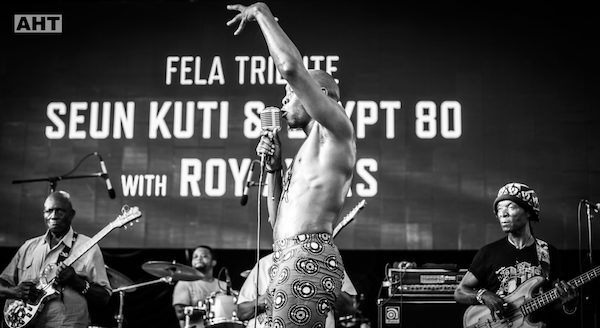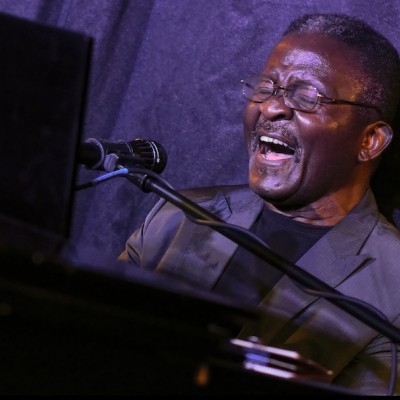Mar 18, 2025 3:00 PM
A Love Supreme at 60: Thoughts on Coltrane’s Masterwork
In his original liner notes to A Love Supreme, John Coltrane wrote: “Yes, it is true — ‘seek and ye shall…

Seun Kuti (foreground) performs during the Paris New York Heritage Festival in Manhattan on July 16.
(Photo: Adrien H. Tillmann/facebook.com/parisnyfestival)Was the decision to sandwich vibraphonist Roy Ayers in between two sprawling Afrobeat bands a savvy piece of jazz advocacy, or just luck of the draw? Putting Brooklyn’s Underground System back-to-back with Seun Kuti & Egypt 80 on a Paris-New York Heritage Festival triple bill on July 16 in Manhattan’s Central Park would have saved the stage crew a long game of musical chairs—and validated a decades-old, Nigerian dance party tradition. On the other hand, it was encouraging to see Ayers get the chance to connect with a crowd of young listeners who might not know his work, even if that meant a lot of diehard fans, who had expected him to headline as originally advertised, ended up missing his set.
These days, Ayers plays the malletKAT Pro, an electronic vibraphone which can be a dead ringer for the acoustic instrument. Early in the set, it wasn’t: Technical glitches kept his whirling mallets out of the mix for a few minutes. Leading a quartet with Fender Rhodes, Fender bass and drums, Ayers went for double the nocturnal glimmer and ripple that has been his trademark throughout parts of seven decades.
They had time for just three 15-minute jams on the hits “Red, Gold And Green,” “Everybody Loves The Sunshine” and “Searchin’.” The idiom was pure 1980s, although the rhythm section was far more terse and purposeful than typically found in that era’s fusion. Ayers’ elegantly bluesy triplets, rapid-fire chromatic lines and judicious against-the-beat metrics reflected an earlier era, when he’d been a protégé of Lionel Hampton and mentored by Bobby Hutcherson. Meanwhile, his group kept a tight focus, save for a couple of warpy keytar interludes and a snazzy behind-the-back drum solo that ended with an over-the-shoulder flip of the sticks.
Ayers saved his most energetic, explosive volleys for a cameo with Kuti and his brassy, percussion-heavy 14-piece ensemble. The son and principal heir to Afrobeat pioneer Fela Kuti’s legacy has his father’s firebrand political sensibility, even if he hasn’t had to cope with the brutal repression of 1970s Lagos. Railing against the hypocrisy of “conscious capitalism” and noting that the peddling of half-truths from the executive branch has been de rigeur in Nigeria longer than it has been here, he took a brief turn on electric piano before displaying a bright, metallic Jackie McLean-like tone and fondness for allusive modes on alto sax.
He and the group opened with Fela’s abrasive 1975 condemnation of conspicuous consumption, “Expensive Shit.” In the 10 minutes it took to simmer and bubble to the conclusion, Kuti probably spat that four-letter word more times than any other act at this venue in the past several years. The rest of the set ran the gamut from a defiant pro-ganja anthem to “African Dreams,” a hypnotically undulating broadside against western cultural imperialism and how generations of young Africans have been seduced.
Bounding and strutting across the stage with an earthy gusto, singer-flutist Domenica Fossati—a charismatic whirlwind of Italian and African-American ancestry—led hometown crew Underground System through the afternoon’s longest and arguably most dynamic set, mixing up original Afrobeat with a more straight-up funk tune and a passionate Italian women’s rights anthem. Guitarist Peter Matson’s occasional departures into enigmatic noise and jagged funk were counterbalanced by keyboardist/organist Colin Brown’s keening whir over a slinky backdrop. The high point was the brassy “Rent Party,” something Fossati said the band knew a little something about.
Many faces in the crowd went west to Pier One on the Hudson for an afterparty, where Innov Gnawa—a traditional Moroccan trance-dance band—kept the crowd on their feet throughout a couple of otherworldly sets. Bandleader Hassan Ben Jaafar and his protégé, Samir LanGus, took turns playing hypnotic, artfully polyrhythmic riffs on three-string sintir bass-lute as the choir, singing in Arabic and clanking their cast-iron castanets, provided waves of call-and-response on ancient sub-Saharan, pre-Muslim animist themes.
As the night went on, Ben Jaafar subtly introduced a series of suspenseful chromatics, hinting at more Egyptian and Middle Eastern-flavored hmadcha modes. Eventually, percussionist Amino Belyamani sauntered into the dancing melee to teach them some moves. Fresh off an appearance at Coachella, this band is on the rise: Their agenda is to do for gnawa what Bob Marley did for reggae … or what Ayers did as an avatar of psychedelic, cinematic funk in the 1970s. DB

“This is one of the great gifts that Coltrane gave us — he gave us a key to the cosmos in this recording,” says John McLaughlin.
Mar 18, 2025 3:00 PM
In his original liner notes to A Love Supreme, John Coltrane wrote: “Yes, it is true — ‘seek and ye shall…

The Blue Note Jazz Festival New York kicks off May 27 with a James Moody 100th Birthday Celebration at Sony Hall.
Apr 8, 2025 1:23 PM
Blue Note Entertainment Group has unveiled the lineup for the 14th annual Blue Note Jazz Festival New York, featuring…

“I’m certainly influenced by Geri Allen,” said Iverson, during a live Blindfold Test at the 31st Umbria Jazz Winter festival.
Apr 15, 2025 11:44 AM
Between last Christmas and New Year’s Eve, Ethan Iverson performed as part of the 31st Umbria Jazz Winter festival in…

“At the end of the day, once you’ve run out of differences, we’re left with similarities,” Collier says. “Cultural differences are mitigated through 12 notes.”
Apr 15, 2025 11:55 AM
DownBeat has a long association with the Midwest Clinic International Band and Orchestra Conference, the premiere…

“It kind of slows down, but it’s still kind of productive in a way, because you have something that you can be inspired by,” Andy Bey said on a 2019 episode of NPR Jazz Night in America, when he was 80. “The music is always inspiring.”
Apr 29, 2025 11:53 AM
Singer Andy Bey, who illuminated the jazz scene for five decades with a four-octave range that encompassed a bellowing…